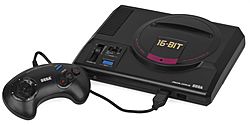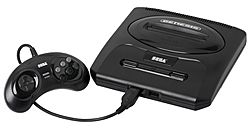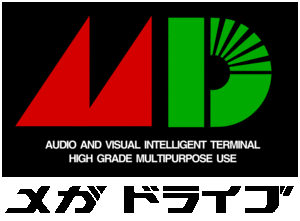Sega Genesis facts for kids
|
Top: Original Japanese Mega Drive
Bottom: Genesis Model 2 Other variations are pictured under Variations below |
|
| Manufacturer | Sega |
|---|---|
| Type | Home video game console |
| Generation | Fourth generation |
| Release date |
|
| Retail availability |
|
| Discontinued |
|
| Units sold |
|
| Media | ROM cartridge |
| CPU |
|
| Display | |
| Sound |
|
| Online services | Sega Meganet Sega Channel XBAND |
| Best-selling game | Sonic the Hedgehog (15 million) |
| Backward compatibility |
Master System |
| Predecessor | Master System |
| Successor | Sega Saturn |
The Sega Mega Drive, known as the Sega Genesis in North America, is a 16-bit video game console. It was made by Sega. This was Sega's third home video game console. Sega first released it in Japan in 1988. It came out in North America in 1989.
In Japan, the Mega Drive did not sell as well as its rivals. These were Nintendo's Super Famicom and NEC's PC Engine. However, it became very popular in North America, Brazil, and Europe. It sold well for many reasons. It had many arcade games that you could play at home. It also had Sega's famous Sonic the Hedgehog games. Popular sports games helped too. Sega also used strong marketing to make the system seem cool for teens. Some games, like Mortal Kombat, caused discussions about violence in games. This led Sega to create the Videogame Rating Council. This group helped people know what was in games. It was a step towards today's Entertainment Software Rating Board (ESRB).
Over 30 million Genesis consoles were sold by Sega worldwide. Even in the mid-2010s, other companies were still selling new versions of the Genesis. Many of its games have been re-released. You can find them in game collections or on online services. These include the Nintendo Virtual Console, Xbox Live Arcade, PlayStation Network, and Steam. The Sega Saturn replaced the Genesis in 1994.
Contents
How the Genesis Was Made
Early Console Ideas
In the early 1980s, Sega was a top company for making arcade games in the United States. But around 1982, the arcade business slowed down. This made Sega think about new ideas. Hayao Nakayama, who led Sega Enterprises, Ltd. in Japan, thought the company should start making home video game consoles. This was a new market at the time.
Nakayama got permission to try making home consoles. Sega's first home system was the SG-1000, released in 1983. It sold well for Sega, but Nintendo's Famicom came out the same day and sold much better. Sega then made the Sega Mark III a few years later.
Master System and New Plans
In 1986, the Mark III was updated for North America. It was called the Sega Master System. It also came out in Europe in 1987. The Master System was popular in Europe and Brazil. But it did not sell well in Japan or North America. In those places, Nintendo was the clear leader.
Because the Master System wasn't doing well, Sega's team started working on a new console. They began this work right after the Master System was released. This new project would become the Sega Mega Drive, or Genesis.
Why the Genesis is Remembered
The Genesis is often seen as one of the best video game consoles ever. In 2009, IGN, a big gaming website, called it the fifth best console. They liked its sports games and the home version of Mortal Kombat. They also praised its "six-button" controller.
In 2007, GameTrailers said the Genesis was the sixth best console of all time. They said it had great games and a good controller. They also talked about the "glory days" of Sonic the Hedgehog. Another website, GamingExcellence, also put it on their list of top consoles. They called it a "gaming milestone". GameDaily also listed it for its memorable games.
Images for kids
-
The European PAL version of the Mega Drive launched in 1990. It became the best-selling fourth-gen console in Europe.
-
A picture from Sonic the Hedgehog. This is from its first level, Green Hill Zone.
See also
 In Spanish: Mega Drive para niños
In Spanish: Mega Drive para niños













